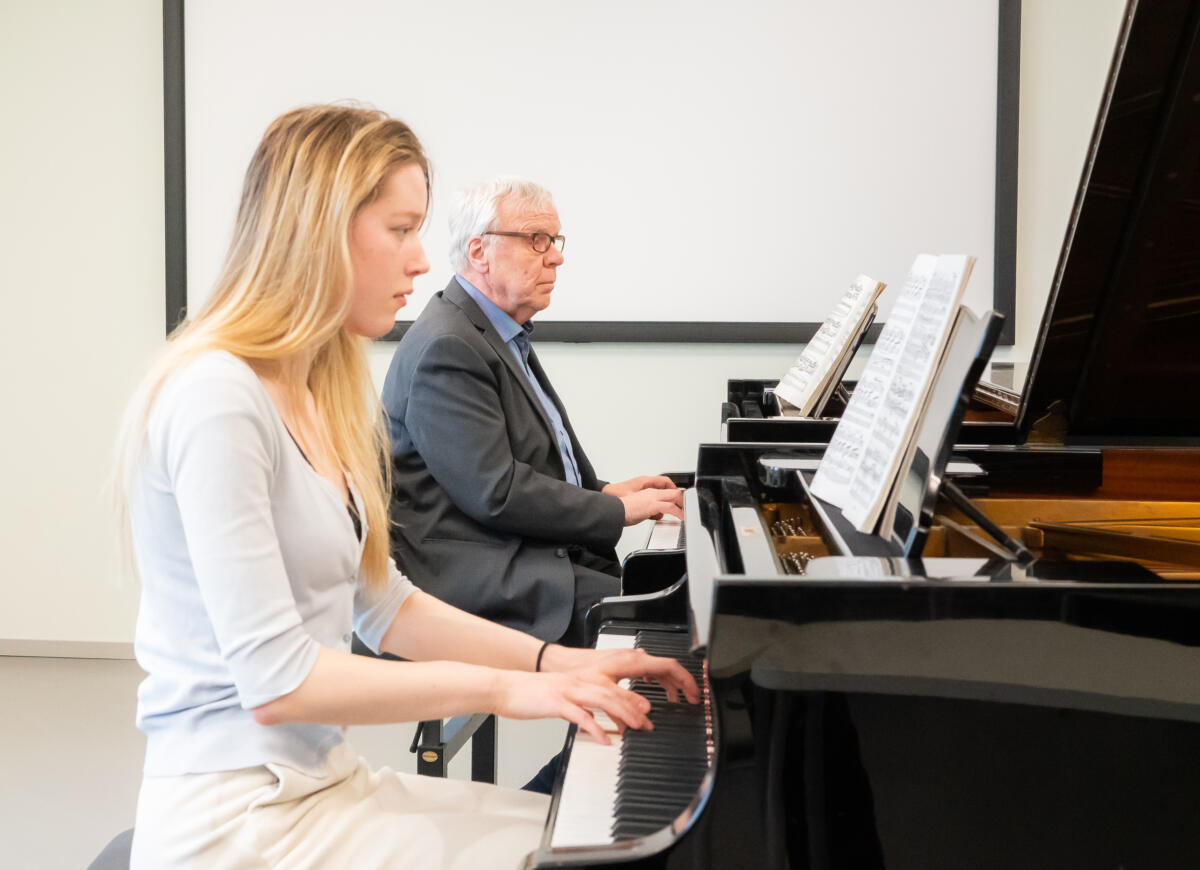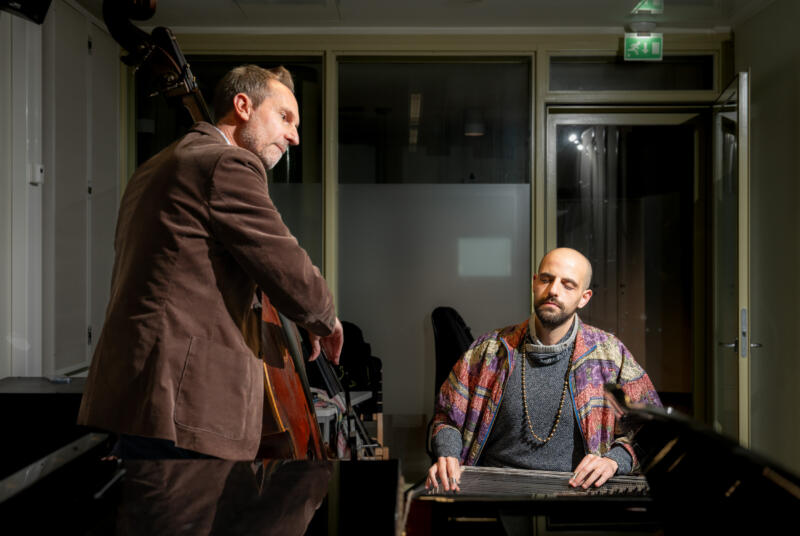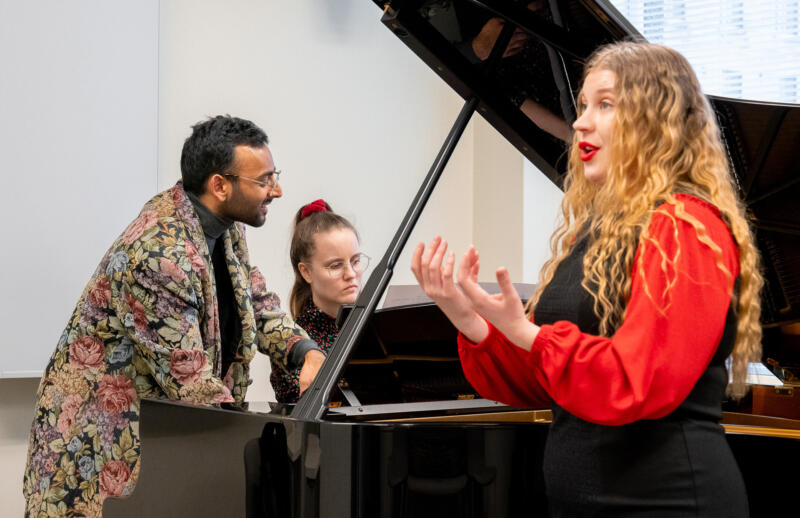Becoming a master: Eero Heinonen and Kiia Nordlund
In this interview series, an arts student and a teacher discuss their shared learning journey.

Pianist Eero Heinonen regularly gives master classes for piano students at the Sibelius Academy. Kiia Nordlund began her piano studies at the Sibelius Academy in 2018. What does a master class entail, and what kind of collaboration do the master and the future master engage in? In this interview series, an arts student and a teacher discuss their shared learning journey.
What do you remember from your first teaching experience together?
Kiia: It was probably Eero’s public master class at the Helsinki Music Centre. I was studying at the Sibelius Junior Academy, where I started at the age of 15. I remember there being quite a large audience, and I played Beethoven’s sonata for you.
Eero: A master class is an old tradition in music education. It essentially means an open class, a lesson where other students and sometimes the general public can come and listen. Pedagogically, it means that the student already knows the piece and comes to seek new, deeper perspectives from someone other than their own teacher. The idea is that even the listeners learn, although in short courses, they may easily overlook the long process preceding the study of a particular piece. In very short courses, one must consider the performer and the music as a whole.
Kiia: For students, the master classes are a great opportunity. For example, Eero is not my regular teacher, but we meet occasionally. However, we have worked together several times over the years – this way, the teacher can see the development over a slightly longer period and can still provide an outsider’s professional perspective. I also think that one can learn a lot by listening to others’ teaching. Of course, each performer is different and everyone needs different tools. However, there are many common aspects that students can develop. By listening to others, you often notice them better.
How would you describe your teacher-student relationship at the moment?
Eero: When Kiia played for me for the first time, she was still at the Sibelius Junior Academy. Of course, there has been a tremendous change in her skills since then. Over time, we have become more familiar: I know who she is and how she reacts. The collaboration has gone well from the beginning. Kiia has always been receptive – some students are incredibly quick to grasp and can gain many new ideas even in just one hour.
Kiia: As the collaboration progresses, you begin to understand a bit what kind of person the other one is and what kind of teaching style they have – you know what to expect. It’s also nice to notice that with each collaboration, you get more out of it.
What is the most important thing in teacher-student interaction?
Kiia: I think it starts with a feeling of being accepted and safe: it’s important as a student to feel that the teacher listens and helps. Music often evokes strong emotions and has a personal dimension for each performer. I believe that the most fruitful collaboration can begin when there is room to experiment and play as oneself. Especially in short master classes, I think it’s the student’s obligation to take advantage of the opportunity and try things, even if they are musically contradictory to their own thoughts. The exact purpose of master classes is getting different ideas and perspectives to try out.
Eero: I think this is a good approach to master classes. For a teacher, it is of course always interesting to hear how students play. Sometimes you come across pieces that you haven’t played yourself, and I always familiarise myself with them beforehand. When a student starts playing, often already during the first few bars, my mind can immediately be filled with new ideas. This is how educational interaction naturally works. In this profession, it’s particularly enjoyable to connect with young people. Those studying classical music are usually incredibly smart and inherently motivated. We as pianists often get stuck in the black and white of the keys. I try to aim for music to always have spirit and life – I try to open up the contents of music so that playing doesn’t become mere execution.
How do you give feedback to each other?
Eero: Artists usually have a high level of self-criticism. I often don’t receive verbal feedback from students; instead I assume they probably discuss among themselves what the lesson was like. As a teacher, I receive feedback immediately through the act of playing – I hear when a student learns and understands.
Kiia: Eero, like other teachers, is a master in the sense that they kindly share their knowledge and experience with us younger colleagues. I feel that as a student and a younger colleague, it’s worthwhile for me to absorb as much advice as possible from an artist and teacher who has been in the field longer, rather than giving them feedback, especially when there are no conflicts or problems.
What have you learned from each other?
Kiia: It’s difficult to pinpoint any one specific thing: all of this, including working with Eero, is, in my opinion, part of a larger journey towards the rich core of the world of music – a part of the whole journey.
Eero: In general, every student has added to my understanding of music and the diversity of people as recipients of it. I constantly have to come up with new ways to help students. Kiia is a quick reactor – through that, too, I learn from her, even though I’m in the role of the teacher.
What does the traditional master-apprentice relationship, the deep personal relationship between a teacher and a student, mean to you in studying music?
Eero: Instrumental studies simply cannot be done without personal instruction. This needs to be emphasised repeatedly when decisions are made regarding funding and organisation. Music education has its own uniqueness. It’s a centuries-old tradition in the arts; the experienced ones teach skills that the younger generation adopts through their own individual personas. Even in orchestras, there are always about a hundred people who have started their music studies no later than school age and have received instrument training through personal instruction. In this respect, the core of music culture lies in music schools and conservatories, where the heritage of personal instruction in the arts is upheld. A child often forms a very personal relationship with their music teacher: they can be the person outside their home who they can trust.
Kiia: From the student’s perspective, it is invaluable to have close personal relationships with teachers. They are the people from who you can draw knowledge, who nurture curiosity and desire for development and who support you. They have immersed themselves in these subjects throughout their entire lives. A musician’s and artist’s career is not a sprint: it doesn’t end when studies are completed, but it is a lifelong journey.

